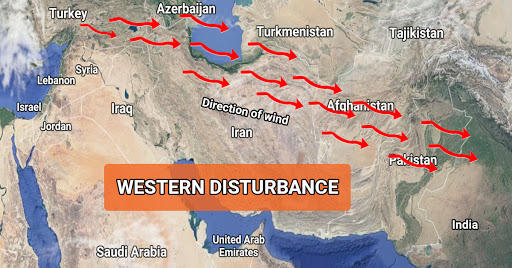What are ‘Western disturbances’?
The India Meteorological Department (IMD) projected that; western disturbance is likely to hit the eastern states from January 11, 2022.
Key Points
- Making these predictions, IMD issued yellow and orange alerts for the states of Jharkhand, Odisha, West Bengal and Bihar, for January 11 to January 13.
- Scattered to fairly widespread light or moderate rainfall is expected over these states.
- Isolated thunderstorms with lightning or hail are also predicted for Jharkhand, Bihar & Gangetic West Bengal on January 11 while for Sub-Himalayan West Bengal, Sikkim & Telangana on January 12.
What is western disturbance?
Western disturbance is an extratropical storm originating in Mediterranean region. The disturbance brings sudden winter rain over northern parts of Indian subcontinent. It extends in east up to northern parts of Bangladesh and South eastern Nepal. It is a non-monsoonal precipitation pattern and is driven by the westerlies. Western disturbances are more frequent and stronger in the winter season.[6]
How moisture originates?
The moisture in such storms originates over Mediterranean Sea, Caspian Sea and Black Sea. Extratropical storms are a global phenomenon, wherein moisture is carried in upper atmosphere. They are different than their tropical counterparts, in which moisture is carried in lower atmosphere. In Indian subcontinent, moisture is shed as rain when this storm system encounters the Himalayas.
Significance of Western Disturbances
Western disturbances are significant for the development of Rabi crop, which includes staple wheat.
How is it formed?
Western disturbances originate in the Mediterranean region. A high-pressure area over Ukraine and its neighbourhood consolidates. The consolidation results into intrusion of cold air from polar regions towards an area of warmer air with high moisture. It creates favourable conditions for cyclogenesis in upper atmosphere, leading to formation of an eastward-moving extratropical depression. The disturbance travels at the speed of up to 12 m/s, towards the Indian subcontinent until Himalayas inhibits its development. After this, the depression rapidly weakens.
Month: Current Affairs - January, 2022
Category: Environment Current Affairs


